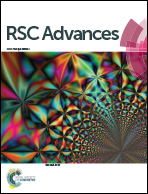H2O2-mediated fluorescence quenching of double-stranded DNA templated copper nanoparticles for label-free and sensitive detection of glucose†
Abstract
Blood glucose monitoring has attracted extensive attention because diabetes mellitus is a worldwide public health problem. Here, a novel and label-free fluorescent sensing strategy was reported for simple and sensitive detection of glucose in human serum on the basis of H2O2-mediated fluorescence quenching of double-stranded DNA (ds-DNA) templated copper nanoparticles (Cu NPs). In this strategy, the fluorescence intensity of ds-DNA templated Cu NPs was found to be quenched effectively in the presence of H2O2. Similarly, glucose could be monitored based on the enzymatic conversion of glucose by glucose oxidase to generate H2O2. Under the optimized conditions, the strategy exhibited sensitive and selective detection of glucose in a linear range from 50 nM to 100 μM and with a detection limit of 12 nM. In addition, the method was successfully applied in the detection of glucose in human serum samples with satisfactory results. Furthermore, the strategy was free of any fluorescence dye label, complex DNA sequence design, and sophisticated experimental techniques. Therefore, the proposed approach could hold great potential for diabetes mellitus research and clinical diagnosis.


 Please wait while we load your content...
Please wait while we load your content...